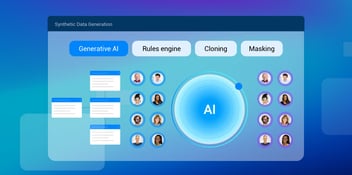Understanding Synthetic Data
Synthetic data is an artificial dataset that mirrors the statistical patterns, properties, and relationships of real-world data. In recent years, synthetic data has surged in significance, with Gartner projecting that by 2024, 60% of the data used in AI will be synthetic.
It’s especially useful in testing software and training Machine Learning (ML) models, where diverse data is needed at scale. It’s also critical for companies who need to comply with data protection regulations like GDPR, CPRA, and HIPAA.
For enterprises that want to maintain a competitive edge, synthetic data generation is invaluable. It gives companies the ability to safely share sensitive data with third parties, mitigating security and compliance risks. Additionally, it enables better data flow within an enterprise, giving teams the ability to collaborate more seamlessly.
Synthetic Data Use Cases by Domain
Synthetic data’s value isn’t just limited to developers and analysts. It can help nearly every team within an organization work more effectively. Here are some industry-agnostic use cases of how different business functions in an enterprise can leverage synthetic data:
-
Human Resources (HR)
HR teams are entrusted with sensitive employee data. Synthetic employee datasets give HR professionals the ability to assess workforce performance, fine-tune training programs, or optimize recruitment processes, without compromising employee privacy. These synthetic datasets mirror real HR data, facilitating analysis and data-driven decision-making while adhering to data privacy regulations.
-
Marketing
Marketing teams, including social media and growth teams, can leverage synthetic data for personalized campaigns. Synthetic customer profiles enable segmentation and targeting without relying on actual customer data. Social media teams simulate user interactions and content engagement to refine strategies, while growth teams leverage synthetic data for A/B testing, optimizing ad campaigns and user experiences. In email marketing, synthetic subscriber lists can be used to test the effectiveness of different templates and subject lines.
-
Analytics
Analytics teams thrive on data, and synthetic data enhances their abilities. For example, synthetic financial data can be used to simulate market scenarios and assess investment strategies without exposing sensitive monetary information. In web analytics, synthetic user behavior data can help in analyzing website traffic patterns and user journeys. Data scientists can also employ synthetic datasets to build and test Machine Learning (ML) models, ensuring they adapt well to real-world scenarios while preserving data privacy.
-
Product
Synthetic data plays an enormous role in helping product development teams accelerate their processes. A synthetic dataset can be used to test new features or enhancements without exposing real user data to potential bugs or issues. For example, product teams can simulate user interactions with the software to ensure that new functionalities work seamlessly before releasing updates to actual users. It can also be useful for optimizing user experience, as synthetic user personas can be used to test how different user groups interact with the application, allowing a team to make informed UX design decisions.
-
DevOps
When using test data management tools to validate software performance, developers often require a large and diverse dataset to ensure the application functions correctly. Synthetic data allows developers to perform rigorous testing without compromising real user data. For example, synthetic data can be used to optimize drug dosages and medical treatments. It also eliminates the need to wait for real data, enhancing flexibility and agility during development.
Synthetic Data Use Cases by Industry
While any company can benefit from using synthetic data, it’s especially valuable in industries that face significant privacy regulations like the General Data Protection Regulation (GDPR) in the EU, the California Privacy Rights Act (CPRA), and the Health Insurance Portability and Accountability Act (HIPAA) in the US.
For this reason, healthcare, insurance, and finance are some of the industries seeing the most drastic benefits from synthetic data. Here’s a look at some of the most common use cases for synthetic data in these industries:
Synthetic Data in Healthcare
When it comes to healthcare, data access is critical for innovation, but privacy regulations like HIPAA can make it difficult for researchers to access the data they need. Synthetic data in healthcare facilitates research and medical testing without exposing Personally Identifiable Information (PII).
Medical professionals rely on synthetic data for training and simulation, practicing procedures, diagnostics, and treatment plans. Imaging diagnostic algorithms are evaluated using synthetic data's realistic yet fictitious medical images.
Predictive models prevent disease outbreaks, optimizing resource allocation, while population health analysis studies trends without compromising patient identities. Personalized medicine thrives on synthetic patient data, enabling tailored treatment plans, and fostering data sharing and collaboration within healthcare institutions while adhering to data protection regulations.
Synthetic Data in Insurance
Amid evolving industry practices and stringent data privacy regulations, insurers can harness synthetic data to enhance underwriting precision, strengthen fraud detection, and improve claim predictions, all while complying with privacy and legal frameworks.
Fraud is one of the biggest issues insurance companies deal with, and synthetic data significantly strengthens fraud detection capabilities. By training ML models to recognize genuine claims, insurers can identify suspicious patterns and reduce false positives – combating insurance fraud while safeguarding customer privacy. Synthetic data is also good at optimizing claim predictions.
Insurers can leverage a synthetic dataset to simulate various claim scenarios and assess their financial impact. For instance, by analyzing synthetic data representing different claim types and severities, insurers can proactively allocate resources and manage financial reserves, ensuring they are well-prepared to meet policyholder obligations. This data-driven approach not only enhances financial stability but also fosters trust among policyholders by facilitating more accurate claim settlements.
Synthetic Data in Finance
Financial institutions grappling with GDPR fines and data access challenges turn to synthetic data for compliance. It facilitates long-term analyses, improves customer purchase prediction, and refines fraud detection.
Notably, global giants like Amazon and American Express have been exploring the potential of synthetic financial data to enhance machine learning and refine fraud detection algorithms. Synthetic data is reshaping the landscape, offering powerful tools across diverse sectors, from risk management and credit assessments to compliance and fraud detection.
Synthetic Data for Your Organization
Many forward-thinking companies are learning how to create synthetic data all by themselves. synthetic data. When considering the various synthetic data companies to partner with, choose the solution that can synthesize data through a variety of different means. The most advanced synthetic data solutions leverage business entities (such as customers, orders, or loans), which are automatically modeled on metadata from the original datasets.
A business entity approach ensures that data relationships, hierarchies, and referential integrity are maintained and valid. Entity-based synthetic data generation tools use a variety of different techniques, alone or together, including generative AI, rules engineering, entity cloning, and data masking. K2View is the only company that supports all 4 techniques via a business entity approach.
Learn more about K2view entity-based synthetic data generation tools.
















